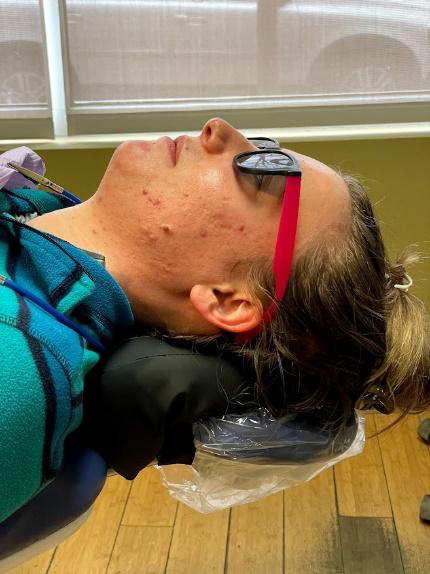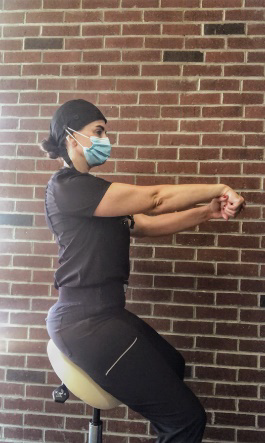
Stephanie Botts, RDH, BSDH, CEAS
Stephanie has been a full-time clinical dental hygienist for 13 years. She is a Certified Ergonomics Assessment Specialist providing both in-office and virtual ergonomics consulting and coaching to dental professionals. Her experience as a clinical dental hygienist and ergonomics expert has allowed her to recognize the unique challenges of practicing pain-free in the dental setting.
Dental hygiene is a rewarding yet sometimes challenging profession. Most of us are type-A, perfectionist personalities while also being caretakers. These qualities are what make us excellent clinicians and advocates for the well-being of our patients. Unfortunately, those same qualities can lead us to put everyone else's needs before our own, which only makes us suffer in the long-run.
As an ergonomics coach and practicing dental hygienist, I have seen the effects this dedication can have on physical and mental health. After coaching numerous hygienists, I’ve identified six habits that can lead to ergonomic injury and career burnout.
1. Working From An Empty Cup
Have you heard the saying, "You can't pour from an empty cup?" This phrase perfectly illustrates the importance of self-care and putting yourself first. As hygienists, we must prioritize our physical, mental, and emotional well-being to perform our duties with excellence and to our satisfaction. Working in a caring profession can be draining and many practitioners eventually leave due to burnout or injury. To prevent this, you must fill your cup.
What does it mean to fill your cup?
To fill your cup means to restore and replenish your physical, mental and emotional energy. It’s as simple as doing a few things for yourself each day.
How do I refill my cup?
The easiest way to refill your cup is to think about what makes you happy and do more of it! This can be reading, cooking, watching TV, spending time with family, gardening or anything else that feeds your soul. It is vital to take time to do the things we love with who we love (or all by ourselves)!
2. Putting Patients' Needs Before Your Own
I know, this sounds counterintuitive. But our needs are just as important as those of our patients. In fact, they are more important. We cannot provide the level of care we desire if we don't attend to our needs first.
How to put your needs first
3. Not Fully Reclining the Patient
This is something I see almost all the time, and something I struggled with too. We want our patients to be as comfortable as possible, which usually means giving in when they say they can't go back very far or not even trying to fully recline them in the first place.
What are the consequences of not fully reclining the patient?
What are some actionable tips to try on your next patient?
Here are some tips and tricks you can easily try the next time you’re in clinic:
- Try tipping patients back in slow little increments
- Support their cervical spine with a cushion before reclining
These small actions can help put patients at ease and lessen their objections. Do you have additional tips that have worked for you in the past? Let us know in the comments.
4. Improper Head Positioning
Getting the occlusal planes properly oriented is crucial when trying to visualize and scale without compromising proper posture.
How do you properly position your patient’s head?
The first step is to have the patient "scoot" all the way back in the chair. The tops of their shoulders should align with the top of the backrest, thereby positioning their head on the headrest. Many patient chairs have double articulating headrests that can be an asset in achieving proper positioning when used correctly. The headrest should be tipped steeply back for the maxillary arch and tipped forward to scale the mandibular arch. If the chair has a flat headrest, cervical cushions can be used to orient the occlusal planes.

© 2021 Stephanie Botts, PosturePros, LLC. All rights reserved.
5. Abducting the Arms
Another habit I see frequently is abducting the arm away from the body (in other words, the chicken wing pose)! This posture places incredible strain on the arms, shoulders, neck, and back.
Why is my arm abducting?
Typically, this happens when the patient isn't leaned back far enough or the chair is not down far enough. Ideally, the patient's head should be in your lap area; this will allow the arms to stay close to the sides with the elbows bent at 90°.

© 2021 Stephanie Botts, PosturePros, LLC. All rights reserved.
6. Skipping Microbreaks
Yes, I am asking you to take breaks during your appointment. I promise, this is entirely doable!
What is a microbreak?
Microbreaks are 20-30 second stretch breaks every 20 minutes or so. Part of what makes dental hygiene so physically demanding is the inability to rest our overworked and fatigued muscles. Microbreaks allow much-needed blood and oxygen back into the muscles, healing micro-trauma that occurs when practicing in static postures.
How to incorporate a micro-break in your appointment:
You can take a microbreak when changing from power to hand scaling, from scaling the maxillary to mandibular arch, or between scaling and polishing. Stretching as much as possible throughout the day, whether it be chairside, walking down the hallway, between patients, or debriefing the doctor is one of the most important things we can do to restore health and function to our bodies.

© 2021 Stephanie Botts, PosturePros, LLC. All rights reserved.
We do a technically precise and demanding job while caring for our patients' needs and making them at ease. We counsel our patients every day, all day, on the importance of attending to their oral health. Let's take that same passion and conviction and direct it back onto ourselves. Start by breaking these six bad habits and start making yourself a priority.
About Stephanie:
Stephanie Botts has been a full-time clinical dental hygienist for 13 years. She is a Certified Ergonomics Assessment Specialist providing both in-office and virtual ergonomics consulting and coaching to dental professionals. Her experience as a clinical dental hygienist and ergonomics expert has allowed her to recognize the unique challenges of practicing pain-free in the dental setting. Stephanie believes that dental professionals can practice pain-free and ensure career longevity by learning practical strategies to optimize proper ergonomics both inside and outside the operatory.
Stephanie can be contacted by email at stephanie@posturepros.net, through her website at www.posturepros.net, or by phone at 907-229-4989.


Submit a Comment